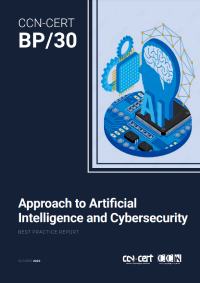Report: on the intersection of AI and Cyber Security
In the last year, the convergence of Artificial Intelligence (AI) and Cyber Security has captured the attention of professionals, experts, and enthusiasts in technology and Cyber Security.
 This is precisely the central theme of the BP/30 report on the Approach to Artificial Intelligence and Cybersecurity recently published by the National Cryptologic Center (CCN-CERT), which provides an overview of what the authors call Artificial Intelligence Cyber Security (AICS). This concept focuses on integrating AI into Cyber Security and OT Cyber Security.
This is precisely the central theme of the BP/30 report on the Approach to Artificial Intelligence and Cybersecurity recently published by the National Cryptologic Center (CCN-CERT), which provides an overview of what the authors call Artificial Intelligence Cyber Security (AICS). This concept focuses on integrating AI into Cyber Security and OT Cyber Security.
◾CCN is Spain's National Cryptologic Center, entity responsible for information and communication technologies security within the scope of the General State Administration. Operating under the direction and supervision of the CNI (National Intelligence Center), its objective is to guarantee Cyber Security in Spain.
◾A CERT (Computer Emergency Response Team) is an organization responsible for coordinating and responding to computer security incidents at a national or regional level.
The CCN-CERT report begins with an introduction defining both AI and Cyber Security and tracing a brief history of their relationship in security. These introductions help understand how AI has revolutionized Cyber Security, “two disciplines with origins clearly separated in time that have seen their competencies converge into what currently constitutes a new practical activity.”
Although machine learning techniques for intrusion detection emerged in the 90s, AI began to play a significant role in cybersecurity in the 2010s.
Fundamentals of AI in Cyber Security
A key section of the report focuses on AI fundamentals. Here, concepts such as Machine Learning (ML), Deep Learning (DL), classification algorithms, and generative AI are explained. These concepts help understand how AI can be applied in Cybersecurity.
✅ Machine learning allows machines to learn from historical data and make decisions through algorithms. This translates into increased ability to identify cyber threats and suspicious or malicious behaviors.
Given the massive amount of data organizations handle daily, automation through AI has become an indispensable component to improve threat detection efficiency and accuracy. Algorithms like Support Vector Machines (SVM), decision trees, and neural networks are used to identify threat patterns and malicious behaviors in real time.
Applications of AI in Cyber Security
The report highlights several applications of AI in Cyber Security, including:
- Detecting attack patterns and suspicious behaviors, which can help identify and respond in real time to cyberattacks.
- Automating cyber attack response, which can accelerate recovery and reduce impact.
- Predicting cyberattacks, which can help organizations better prepare to face them.
- Identifying and authenticating users, which improves system and network security.
- Automated vulnerability analysis and pentesting, which can help organizations identify and remediate security vulnerabilities more efficiently.
- Defending against automated adversaries, who use AI to launch cyberattacks.
Challenges and limitations of AI in Cyber Security
Despite the benefits AI brings to Cyber Security, the report also addresses challenges and limitations surrounding this technology, including:
- Adversarial attacks against AI models used in Cyber Security, to manipulate or disable them.
- Over-reliance on automated solutions, which can lead to negligence of traditional security measures or create a false sense of security.
- False positives and negatives that can lead to resource loss or threat exposure.
- Privacy and ethical issues, such as personal data collection and use.
✅ Attackers may try to deceive AI systems by introducing malicious data to avoid detection or penetrate a system. This may include injecting prompts into chatbots. This highlights the need to develop robust and secure AI systems to counter such threats.
✅ Cybercriminals can use Generative AI to orchestrate very sophisticated phishing attacks, with more convincing, contextual, and personalized messages. Additionally, it facilitates hyperrealistic deepfakes, a method of identity impersonation with fraudulent or malicious intent.
CCN-CERT highlights emerging trends in AI and their potential impact on the industry and society, which makes it imperative to anticipate how AI will continue to impact Cyber Security.
The report also addresses several relevant topics in the field of AI and Cyber Security, including:
- Data security: The risk of security failures that expose confidential information is a constant concern. AI plays a key role in identifying and mitigating these risks.
- Profiling: AI's ability to profile individuals based on their online behavior raises ethical and privacy issues.
- Transparency and decision making: AI models' opacity can generate mistrust and difficulties verifying their decisions.
- Bias and fairness: AI can be affected by inherent biases in the data used to train it, which could lead to discriminatory decisions.
- Surveillance and oversight: While AI can be a powerful tool in Cybersecurity, it also raises concerns about potential abuse of user surveillance.
- Accountability and responsibility: Dealing with failures or errors in AI-based systems is a complex challenge.
- Regulations and ethical guidelines: The need for clear regulatory frameworks becomes increasingly evident as AI integrates more deeply into Cyber Security.
🔵 The CCN-CERT report BP/30 Best Practices Report on Approach to Artificial Intelligence and Cybersecurity can be freely downloaded in English. Is a valuable source of knowledge for those interested in understanding how AI is transforming Cyber Security.
* * *
Image by Starline on Freepik.
 Hybrid Cloud
Hybrid Cloud Cyber Security & NaaS
Cyber Security & NaaS AI & Data
AI & Data IoT & Connectivity
IoT & Connectivity Business Applications
Business Applications Intelligent Workplace
Intelligent Workplace Consulting & Professional Services
Consulting & Professional Services Small Medium Enterprise
Small Medium Enterprise Health and Social Care
Health and Social Care Industry
Industry Retail
Retail Tourism and Leisure
Tourism and Leisure Transport & Logistics
Transport & Logistics Energy & Utilities
Energy & Utilities Banking and Finance
Banking and Finance Sports
Sports Smart Cities
Smart Cities

.jpg)




